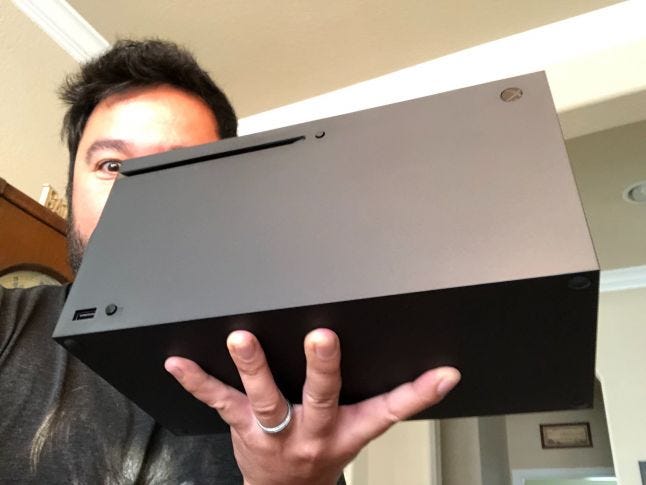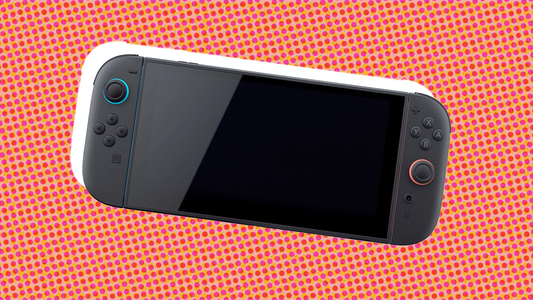Author: by Kris Graft, Chris Kerr
Microsoft provided Gamasutra with Xbox Series X and S units for this review
Xbox Series X
Review by Gamasutra editor-in-chief Kris Graft
When the Xbox One launched in November 2013, it was a bit of an unfocused mess. Microsoft, coming off the success of its Xbox 360 in the face of Sony's PlayStation 3, intended the Xbox One to be more than just a game console.
It would be the "one" always-online hub for all living room media and entertainment, while the motion-sensing capabilites of Kinect would ride the enthusiasm for gesture-based controls that Nintendo's Wii proved out in the marketplace.
Those ambitions didn't pan out for Microsoft or the Xbox One. Eventually, under current Xbox head Phil Spencer, the console maker dropped the Kinect, and also dropped the whole idea that people would somehow be sitting on their couches yelling and waving hands at their game console to watch TV and play video games.
We note this because it's helpful to remember what the Xbox One was like in its early days in order to appreciate the contrast with the $499 Xbox Series X and $299 Series S, both of which handily represent a more focused strategy than their predecessor. This generation of Xbox is about being a conduit for games across four generations of hardware--and for Xbox's increasingly attractive subscription service.
But let's start here:
Form Factor

You've seen it in pictures already, and at 9.8 pounds it's nearly a pound-and-a-half heavier than the Xbox One X. It's a prismatic, black monolith that is absolutely the most "box" of any Xbox to date. Aside from its disc drive, the power button and its concave vented top (if you're standing it up), it's practically featureless.
The controller is nearly unchanged from current-generation Xbox One controllers aside from noticeably grippier texture on the underside, a share button that operates much like those on PS4 and Switch, and an improved d-pad reminiscent of the Xbox Elite Controller. The most significant change for these new Series X | S controllers is their size--they're slightly smaller, which is nearly visually imperceptible--but you can tell when you hold them, allowing for a more ergonomic and comfortable grip. Essentially, it's a smart evolution of an already extremely good controller.

The Tech
We won't rehash the specs here, as they've been available for months now but here are the main points that make for a very powerful and capable game console:
8X Cores @ 3.8 GHz (3.6 GHz w/SMT) Custom AMD Zen 2 CPU
12 TFLOPS, 52 CUs @1.825 GHz Custom AMD RDNA 2 GPU
16GB GDDR6 w/320 bit-wide bus
1TB Custom NVME SSD (expandable--built-in drive fills up fast with Game Pass)
These components enable Series X games to be played at 4K resolution at 60 frames per second, and for some games and modes up to 120 fps if you have an HDMI 2.1-equipped TV. Along with hardware-accelerated ray tracing and HDR, you get games that are beautiful with bold colors, more convincing contrasts, and at 60+ fps, significantly smoother than most current-gen games.
<iframe title="Embedded content" src="https://imgflip.com/embed/4l3rm4" height="400px" width="100%" data-testid="iframe" loading="lazy" scrolling="auto"></iframe>Not all games will be running at 60+ fps, however, and when you switch from a 60 fps game to a 30 fps game, it's hard to go back to 30. Gears 5 is a graphical showpiece for the console running at 4K and 60 fps on the Series X, with an option to run at 120 fps in multiplayer mode. It's gorgeous. This was one of the few fully-optimized games available during the review period (Microsoft is touting 30 optimized titles on day one).
Sea of Thieves is another Microsoft-published game that got the Series X optimization treatment within our review period. At 4K and 30 fps on Xbox One X, it now runs at 60 fps. Forza Horizon 4's optimization is similar. On Xbox One X, players could choose between a graphics mode and a performance mode; choose to prioritize graphics for 4K at 30 fps, or performance for 1080p at 60 fps. With Series X, players don't have to choose--the game runs at 4K at 60 fps and is even more visually impressive than previous iterations, showcasing improved detail and lighting running at a high framerate.
There are also the much-touted fast load times made possible by the new system architecture. We've seen Xbox One games both optimized and not optimized load 2-4X faster than they load on Xbox One X. For developers working on new games, it just means your players are spending more time playing your game, and according to developers already working on the new Xbox consoles, makes for faster debugging.
These are the kind of performance upgrades you can expect with cross-generational games that are optimized for the Series X, and these are the kinds of experiences you can expect--higher-fidelity of existing games that take advantage of significantly advanced hardware. For the new Xbox consoles, there is no "killer app" or system seller like you might expect from a typical hardware launch. The Series X | S offer the promise of future games like Halo Infinite, Fable, Avowed and eventually something from Bethesda.
This blurring of generations, a tack which (I think) has more pros than cons, does present a conundrum for consumers wondering about value, and whether or not it's worthwhile to be an early adopter in this next generation of Xbox consoles. While PlayStation's marketing mantra for PS5 has been "We believe in generations," Xbox has taken a more PC games-approach in which games can exist and operate across a variety of hardware configurations, taking advantage of each configuration's strengths.
<iframe title="Embedded content" src="https://giphy.com/embed/EuVKqtCOwi0TpVFHtx" height="270px" width="100%" data-testid="iframe" loading="lazy" scrolling="auto"></iframe>Upgrading from an Xbox One to an Xbox Series X or S is the closest analogy there is to a PC player upgrading their graphics card. Games like Gears 5 look great on Xbox One, look better on Xbox One X, and perform best on Xbox Series X. The Series X version of that game in particular is basically Ultra PC settings and the Series S version follows the same performance boosts but minus the 4K. You're not gaining immediate access to a new exclusive game or a drastically new experience--you're gaining performance boosts in currently existing games and getting ready for upcoming games that require more robust hardware.
Note: We'll be publishing a more in-depth technical interview with Xbox's Jason Ronald in the coming days.
Quick Resume
Much has already been said about Quick Resume but its significance is worth reiterating. This feature kept me playing on the Series X for longer sessions, and I'm sure I'm not the only one.
Consider how the unassuming Quick Resume functions: It lets you hop around multiple game states across multiple games, with each game-to-game transition taking seconds. When I would get tired or frustrated with one game, I'd hop on over and start another game, and when I was ready to jump back to another game, I'd just bring up the side menu and select it and start again. This video demonstrates the feature in action:
Before I actually used the feature, I thought it was a nice addition but didn't consider its significance until I put it into practice. Quick resume combined with fast loading times facilitated by the SSD increased how long I play games because I could easily jump between them and also didn't lose interest during a loading screen. People's attention spans are short--these quality of life features facilitated by more powerful hardware help keep people engaged, and encourage people to play your games for longer.
Like you may have heard, load times are 2-4X faster than even the Xbox One X thanks to the SSD, and even non-optimized games benefit from this. Playing older games is extra snappy. When testing out the Xbox 360 version of Mass Effect and Fallout New Vegas, I was slightly taken aback when loading screens were whisked away in a couple seconds.
The significance of back compat
The new Xbox consoles surpass even the 60GB launch PS3 in terms of backwards compatibility when it comes to cross generational play. Ken Kutaragi's ultimate vision of the PS3 was the launch model that could play PS1, PS2, and PS3 games. Xbox Series X|S can play across Xbox, Xbox 360, Xbox One, and Xbox Series X | S.
Typically, the cost and effort that goes into making a console backwards compatible would not prove worthwhile. Some consoles have included actual chips from previous generations within next-gen hardware, while others have gone the emulation route to make older games compatible with new hardware.
The new Xbox consoles run older games natively and it took years to get this to work not just reliably but with visual improvements like "Auto HDR" and in select cases improved framerates. Making a machine backwards compatible can be a costly endeavor, and one that adds just one more bullet point to a feature list crafted for a niche group of early adopters. In other words, for all the cost that may be sunk into backwards compatibility, many people barely use it, if at all.

For Microsoft and Xbox however, adoption of backward compatibility isn't about appealing just to early adopters, or merely bridging the gap between generations (though it does secondarily serve this latter purpose). For Xbox, Microsoft has said backwards compatibility is about game preservation, which is true. But it's also about expanding and adding value to the Game Pass library to make it more appealing for players, and creating a huge base of subscribers.
Think of it this way: Netflix doesn't limit you to viewing movies that were released after 2013, and Microsoft doesn't intend to do that either with its new consoles and Game Pass. This is a strategy in which the hardware absolutely serves the business model, and vice versa. Microsoft's cloud streaming initiative Project xCloud is the cloud-based idealization of this concept--reach as many people as possible with as many games as possible, and of course, they're monthly paying subscribers. Sony has its own new subscription service in PlayStation Plus Collection, an expansion of PlayStation Plus, but comparing that to Game Pass, you see Sony's model is more traditional: sell games and consoles, while subscriptions are secondary.
The lines are blurred between hardware generations, and that's a good thing. Both Sony and Microsoft for years have been working toward smoothing the transition between hardware generations and that's a good thing for developers. The days of game developers needing to learn new hardware and new development environments are in the rearview. For game companies as businesses, there is also less of a need for a total recalculation of the market, and instead they're able to evolve their business models, culling the pieces that aren't working and accentuating the pieces that are.
An old axiom for a game consoles' potential success or failure is that 'it's all about the games,' meaning that no matter how advanced the hardware may be, it's the games--the experiences--that will sell consoles. That still holds true, but now it's also about how they're delivered, it's about value, and a next-gen console's success at launch isn't necessarily tied to an exclusive "killer app"--or at least that's what Microsoft may be hoping.
Erasing generational lines
As Xbox's Spencer put it over a year ago, "The business isn’t how many consoles you sell. The business is how many players are playing the games that they buy, how they play." Granted, consoles are a major way that players play games, so installed base isn't a moot point. But it's true that Xbox is squarely in the subscription business as much as it is in the development, publishing and hardware business now. And with Xbox Series X | S, Microsoft has delivered two highly appealing entry points that can turn players into long-term customers, while at the same time erasing the idea of "generations," exposing people to more games, past, present and future. That is a very good thing that I think will resonate with many players.
Xbox Series S
Review by Gamasutra news reporter Chris Kerr
Microsoft is releasing two consoles this generation. There's the $499 Xbox Series X, which is being touted as the hefty all-powerful flagship that'll brute force a whole 12 teraflops into your brain, and the other is the $299 Xbox Series S, an altogether more unassuming console that's no less impressive.
In pure design terms the Series S is a corker. If you're at all concerned by the fact that the other next-gen boxes might not fit inside your house, let alone your TV unit, the Series S is the salve you've been seeking. The compact device is being marketed as the smallest Xbox ever and weighs in at 4.25 lbs.
Compare that to the Series X, which is significantly wider and at 9.8 lbs more than twice as heavy as the Series S, and you'll have some idea as to why Microsoft's sleek "robot white" cuboid is an attractive proposition for people who don't want to cordon of an entire section of their home in the name of video games.
What's in the box?

Despite being significantly smaller than the Series X, the Series S is no slouch. Although it features a smaller 512GB SSD and lacks a disc drive, it boasts similar CPU and I/O performance and uses the same Xbox Velocity Architecture as the Series X to deliver over 40x the I/O bandwidth of an Xbox One. Here are some tech specs that show precisely what's under the hood.
No tags.





































